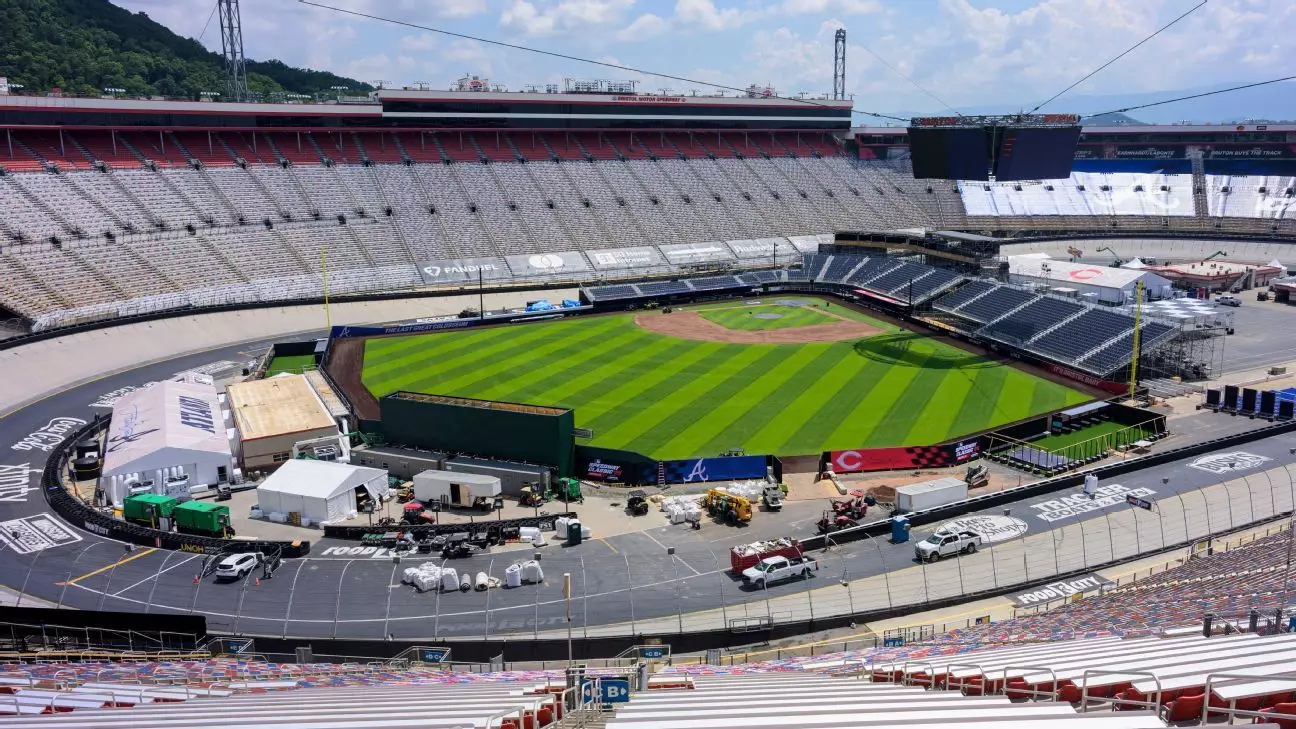Bristol Motor Speedway, renowned as “The Last Great Colosseum,” has long stood as a monument to motorsport excellence, mesmerizing millions with its thunderous races and electrifying atmosphere. However, its historic significance transcends just one discipline. Hosting a groundbreaking Major League Baseball game set a new precedent, proving that this iconic track can transcend its traditional role and become a multi-sport powerhouse. The recent MLB regular-season game between the Atlanta Braves and Cincinnati Reds shattered attendance records and demonstrated Bristol’s capability to adapt and innovate. Yet, this achievement also laid bare the immense logistical challenge of reversing the transformation—shifting from a baseball field back to a racetrack requires meticulous planning, precision, and an unwavering commitment to excellence.
The Transformation Challenge: Engineering Marvels and Logistical Precision
Converting Bristol Motor Speedway from a baseball diamond back into a premier racing venue is nothing short of a marvel in logistical engineering. Major League Baseball’s use of BaAM—a sophisticated construction and design solution—allowed for rapid and effective creation of makeshift clubhouses, batting cages, and broadcast booths. But the real challenge lay beneath the surface: reshaping the infield with 17,500 tons of gravel and 340 tons of Pennsylvania clay to recreate a perfectly level racing surface. Every detail matters; a slight misalignment or improper curing time for poured concrete walls could compromise safety and performance during the upcoming NASCAR race.
The transition isn’t just about laying new surfaces. It involves dismantling temporary structures, removing and reconfiguring walls, and ensuring the integrity of the entire facility. This process demands rigorous coordination among crews working around the clock—disassembling in the early hours after a game, then rebuilding in time for NASCAR’s return. Such a rapid turnaround tests not only engineering capabilities but also the resilience and responsiveness of the operations team.
Moreover, the utilization of materials like gravel and plywood to aid disaster relief efforts—such as hurricane recovery—reflects a commendable commitment to environmental and social responsibility. This approach showcases that stadium transformations can serve purposes beyond sport, becoming catalysts for community betterment.
Balancing Sporting Cultures and Future Potential
The record-breaking baseball game, which drew over 91,000 paying spectators, proved Bristol’s versatility as a sporting venue. Yet, the venue’s true potential extends far beyond a single event. The careful planning of the transition schedule—aiming for completion by September 7—demonstrates confidence that Bristol can maintain its reputation for agility and professionalism. While some may worry about the brevity of this window, the team’s focus on quality over haste underscores a dedication to safety and excellence.
Looking ahead, Bristol’s capacity to host not just NASCAR, but potentially other sports like hockey, signals a bright and ambitious future. The indication from league officials’ interest in Bristol’s handling of major events shows that the venue’s innovative use of space and logistics can inspire other sports leagues seeking to expand their reach or experiment with unconventional venues.
It’s worth noting that this flexibility and willingness to push boundaries is what truly sets Bristol apart. Transitioning between sports involves more than physical changes; it necessitates a cultural shift toward a multi-sport mindset. The ability to shift gears seamlessly and host a variety of events underscores Bristol’s unique position as an adaptable sports hub, capable of elevating its status well beyond its traditional identity.
The Broader Implications: Challenging Norms and Inspiring Innovation
Bristol’s transformation underscores an essential truth: adaptability and innovation are vital to the future of sports venues. In an era where stadiums and racetracks are increasingly expected to serve multiple purposes, Bristol’s example offers a blueprint for others to follow. The venue’s willingness to embrace challenges—whether reconfiguring infield surfaces or accommodating different sports—reflects a forward-thinking mentality that prioritizes versatility, community impact, and operational excellence.
What’s more, this experiment challenges the long-held notion of fixed identities in sports venues. Instead of rigidly serving a single sport, Bristol demonstrates that with ingenuity and meticulous planning, venues can become dynamic spaces that inspire new types of fan engagement and economic opportunities. Such adaptive reuse not only maximizes asset value but also fosters stronger connections between the venue, community, and a broader sporting landscape.
As cities and leagues grapple with rising costs and shifting viewer interests, Bristol’s example signals a future where sports venues are less confined by tradition and more driven by purpose. It reminds us that true innovation often requires boldness, patience, and a willingness to reimagine what a place can be. With each transformation, Bristol reinforces its legacy—not just as a track of speed, but as a symbol of resilience and boundless possibility in the world of sports.


Leave a Reply